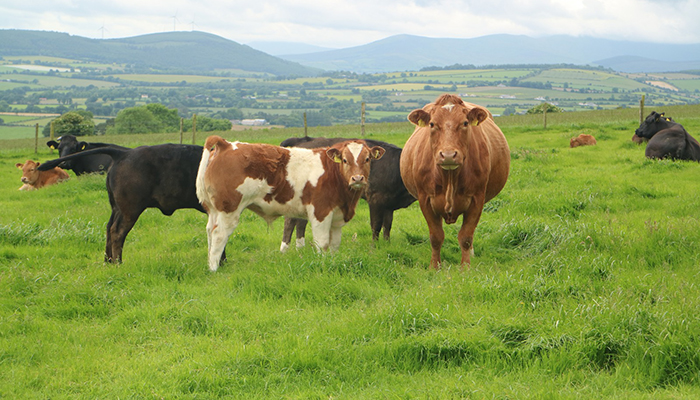16 November 2023
Explainer: Changes to the Terminal and Replacement Indexes – why are they required?

From November 28, suckler farmers may notice a re-ranking of their animals on the Terminal and Replacement Indexes.
The Terminal Index ranks breeding animals on the profitability of their resulting offspring in finishing systems, whereas the Replacement Index focuses on ranking breeding animals on the profitability and merits of their female offspring, becoming the next generation of suckler herds nationally.
On this date, an updated evaluation run will be published by the Irish Cattle Breeding Federation (ICBF) to include changes to the Eurostar Indexes to account for the increased costs of production and prices received at farm level, new and improved technologies to advance genetic gain, as well as the incorporation of key initiatives to mitigate carbon emissions as a means of ‘futureproofing’ Ireland’s suckler industry.
Before looking at how these changes will affect either progeny destined for beef production or those females earmarked to form the backbone of Ireland’s suckler industry, we first need to understand why these changes are being implemented.
Background
Margaret Kelleher, Geneticist with ICBF, provided a background to why both the Terminal and Replacement Indexes are being improved, noting that a reworking of the figures incorporated within the breeding tools hasn’t been undertaken since the launch of the Beef Data and Genomics Programme (BDGP) back in 2015.
“When BDGP was introduced in 2015, there was a huge increase in the level of data recording by farmers due to the requirements of the scheme. Increased data is beneficial to genetic evaluations because it provides more information about each animal that can also be linked to many relatives out in the population.
“The whole process is driven by the desire to increase genetic gain in the right direction as this will increase profit for farmers. To provide farmers with the most accurate genetic proofs, we need accurate data, a lot of data and knowing the parentage of each animal puts us in a strong position to do that.
“The use of genomics during BDGP was another critical turning point, providing us with more detailed genetic information that further enhanced the reliability and accuracy of the evaluations and resulted in genetic gain trending in the right direction for both the Terminal and Replacement Index for the very first time,” Margaret explained.
To put the scale of this data into context, just 15% of sires were recorded on an annual basis in the early 2000s, now over 80% of animals have sires recorded through registration. Additionally, the carcass weight and quality data feeding into the indexes from slaughtered animals has also increased drastically – moving from 200,000 carcasses in the first part of the millennia to over 7 million records.
“We now have over 2 million genotyped records from the suckler herd, which is the largest beef genomic database in the world and has contributed greatly to the enhancement of the genetic evaluations, resulting in more robust and reliable Eurostar Indexes over the last few years for the suckler industry,” Margaret said.
“Both indexes, the Terminal and Replacement Index, select for more profitable and efficient animals for beef farmers and improvements in these will contribute to the industry at large. The motivation for the change now is to improve the beef breeding indexes to better align with the needs of the suckler industry today and to safeguard it into the future.”
A different landscape
The landscape of suckler beef production has changed hugely since the last update to the Terminal and Replacement Indexes was carried out back in 2015. Not only have the costs associated with beef production increased, the prices of outputted product has climbed and an increased awareness of environmental challenges – particularly those of greenhouse gases – has come to the forefront.
“We now have a case where the market prices – the Economic Values included within the Terminal and Replacement Indexes – have been untouched for eight years and it’s a very different landscape then where we were in 2015 in terms of the revenues we are getting in terms of beef and the costs of production such as fertiliser, feed, labour, veterinary and many more,” Margaret commented.
“We also have to be aware of government policy, particularly in regard to our greenhouse gas emission reduction targets. Agriculture is required to reduce its greenhouse gas emissions by 5.75MT; genetics has the potential to deliver 1.2MT of greenhouse gas mitigation. By incorporating carbon into our breeding objectives, we can achieve 20% of our total reduction target, so it is something that we can’t ignore.”
Commenting on the inclusion of carbon within the breeding indexes, Paul Crosson, Beef Enterprise Leader at Teagasc, Animal & Grassland Research and Innovation Centre, Grange, said: “If we look at the current policy agenda, there’s a clear direction in terms of reducing greenhouse gas emissions from all sectors of society.
“Equally, from a consumer point of view, consumers are asking what is the carbon footprint of the food they are consuming and what are food producers doing to reduce the carbon footprint of the food that is being put on the plate in front of them, so we have an obligation in that sense.”
Although producers are not being paid for carbon reductions, Paul said that the inclusion of carbon is a “clear opportunity to futureproof suckler beef systems”.
He added: “If we look around the world in terms of what governments are saying and planning – things like carbon taxes within Europe and a carbon farming platform are starting to emerge – it is quite clear where the direction of travel is. Carbon is something that is viewed as being really important at a consumer and policy level and certainly we can see it in terms of future markets.”
Margaret concluded: “We have shown over the years that genetics has been a trusted and proven technology to deliver. We can make gains in profitability, the sustainability of our suckler herd and it can aid in the delivery of our climate and environmental targets.”
Both Margaret and Paul featured on a recent episode of the Beef Edge podcast, where they outlined the changes to the breeding indexes. Listen in below:
Also read: Chasing cost reductions through breeding – the role of the updated Replacement Index
Also read: Outlining the changes to the breeding indexes
